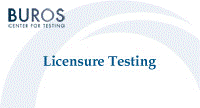Buros-Nebraska Series on Measurement and Testing
Date of this Version
1995
Document Type
Article
Citation
Licensure Testing: Purposes, Procedures, and Practices, ed. James C. Impara (Lincoln, NE: Buros Institute of Mental Measurements, University of Nebraska-Lincoln, 1995).
Abstract
INTRODUCTION
Generally, clinical examinations for licensing (sometimes called performance tests) involve the candidate completing one or more tasks (in licensing this is thought of as "services for a client") that have been selected from the supervised practice Gob analysis) of an occupation or profession. The clinical examination may exist in contexts (occupations) that do not require client interactions. Such contexts include building trades, automobile repair, accounting, etc. The tasks may range from fixing brakes, to preparing a body for burial, to wiring a house, or auditing a set of business interactions.
Other contexts require the candidate to perform services or tasks while interacting with a client. Such tasks include filling a tooth, counseling, fitting contact lenses, hair removal, and similar services. These tasks would then be graded as part of the licensure examination. Supervision or scoring of the tasks in the context where interaction is not required is easier than those requiring the presence of the client. Interaction with clients makes the second type of tasks harder to supervise and to grade. In recent practice, some boards have moved from using live clients to using simulations (Yaple, Metzler, & Wallace, 1992). Oral interviews may be required prior to issuance of a license in some contexts, but such entry orals or group interviews are not considered here as clinical examinations as they seldom are tasks germane to the job analysis of these occupations or professions.
Tests are used as a proxy to judge the ability of an individual relative to actual performance of a task. It might be useful to consider a continuum of faithfulness to the task ranging from a paper-and-pencil (multiple-choice) test to actual performance of the task. This continuum describes the concept of fidelity, or the degree to which the test requires the same behaviors as those required by the task. Unfortunately, this faithfulness to the task is only half of the equation, the other half is accuracy of the inference made about the candidate's ability to complete the task. This dimension speaks to the measurement concept of validity. Both fidelity and validity are complex, thus making a judgment about ability a complex activity.
Human judgment is complex and so intertwined with previous experience that total objectivity is virtually impossible to achieve. So called "objective tests," such as multiple-choice tests, generally moderate judgment by being constructed using multiple judges to determine content and to set cut scores, and by being scored in such a manner that individuals who perform the same task in the same way will attain the same score (often scoring is possible by machine or template). Moving along the continuum toward actual performance (i.e., from multiple-choice tests through essay tests, oral tests, and simulations, to actual clinical performance), the potential gain in fidelity can be offset by loss in objectivity.
Clinical tests appear on the side of the continuum closest to the actual performance of the task. The discussion which follows offers suggestions for enhancing the objectivity in the development and use of the clinical tests. Making scoring judgments explicit, reducing compounding of judgments, utilizing multiple judges in scoring individual performance, and providing statistical evidence of reliability, validity, and fidelity are among the topics discussed.
Performance on a clinical examination generally requires the candidate to use a combination of knowledge gained in training, skills acquired in the education or training program, physical attributes demanded in practice, interpersonal interaction skills, and attitudes. The clinical examination is believed to require candidates to demonstrate their ability to master and apply these different elements in concert. In a discussion with the Advisory Board to Southern Regional Testing Agency (SRTA) at Fort Walton Beach, Virginia, August, 1991, one dentistry board member explained that the clinical examination requires diagnosis, treatment, and patient education cast in the context of dealing with a fearful and uncomfortable patient. It requires practice of the profession along with human management. In dentistry, it was suggested that clinical examination required the candidate to work in the hard-to-reach areas of the mouth without compounding the patient's problems by injury of the areas that make access difficult. Common dental clinical examinations include: one or more types of restoration, prosthetics, and endrodentics.
Included in
Adult and Continuing Education and Teaching Commons, Educational Assessment, Evaluation, and Research Commons, Other Education Commons


Comments
Copyright © 1995 by Buros Institute of Mental Measurements. Digital Edition copyright © 2012 Buros Center for Testing.